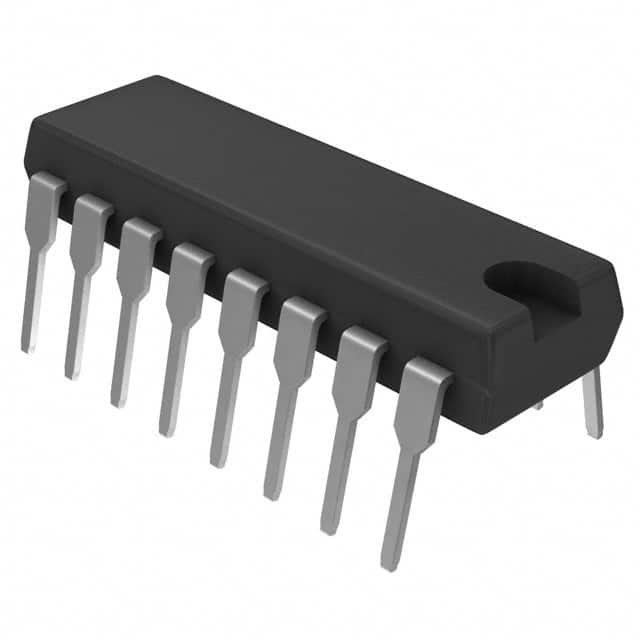Encyclopedia Entry: 74F161APC
Product Information Overview
Category: Integrated Circuit (IC)
Use: The 74F161APC is a synchronous presettable binary counter that belongs to the family of 74F series integrated circuits. It is commonly used in digital electronics and computer systems for counting and timing applications.
Characteristics: - Synchronous operation - Presettable counter - High-speed performance - Low power consumption - Wide operating voltage range
Package: The 74F161APC is available in a 16-pin dual in-line package (DIP), which provides easy integration into electronic circuit boards.
Essence: This IC serves as a versatile and reliable component for various counting and timing tasks in digital systems.
Packaging/Quantity: The 74F161APC is typically sold in reels or tubes, containing multiple units per package. The exact quantity may vary depending on the supplier.
Specifications
The key specifications of the 74F161APC are as follows:
- Supply Voltage Range: 4.5V to 5.5V
- Operating Temperature Range: -40°C to +85°C
- Maximum Clock Frequency: 100 MHz
- Number of Counting Stages: 4
- Maximum Count Value: 15 (binary)
- Input/Output Compatibility: TTL (Transistor-Transistor Logic) compatible
Detailed Pin Configuration
The pin configuration of the 74F161APC is as follows:
+---+--+---+
CLR |1 +--+ 16| Vcc
CLK |2 15| Q0
P0 |3 14| Q1
P1 |4 13| Q2
P2 |5 74F161APC 12| Q3
P3 |6 11| PE
GND |7 10| CET
PR |8 9| TC
+----------+
Functional Features
Synchronous Operation: The 74F161APC performs counting operations synchronously with the clock signal, ensuring accurate and reliable counting.
Presettable Counter: This IC allows presetting the initial count value using the parallel input pins (P0-P3), providing flexibility in counting applications.
Ripple Carry Output (TC): The TC pin generates a carry output signal when the counter reaches its maximum count value, enabling cascading multiple counters for extended counting ranges.
Clear Input (CLR): The CLR pin resets the counter to zero when activated, allowing easy initialization of the counting process.
Parallel Enable (PE) and Count Enable (CET): These pins control the enable/disable functionality of the counter, providing additional control over the counting operation.
Advantages and Disadvantages
Advantages: - High-speed performance enables efficient counting in time-critical applications. - Low power consumption contributes to energy-efficient designs. - Wide operating voltage range ensures compatibility with various digital systems. - Presettable feature enhances flexibility in counting applications.
Disadvantages: - Limited number of counting stages restricts the maximum count value to 15 (binary). - Requires external components for more complex counting tasks.
Working Principles
The 74F161APC operates based on synchronous binary counting principles. It utilizes flip-flops and combinational logic to perform counting operations. The counter advances by one count on each rising edge of the clock signal, unless disabled by the count enable (CET) pin. The parallel inputs (P0-P3) allow presetting the initial count value, while the clear input (CLR) resets the counter to zero. The ripple carry output (TC) generates a carry signal when the maximum count value is reached, enabling cascading of multiple counters.
Detailed Application Field Plans
The 74F161APC finds applications in various digital systems and electronic devices, including but not limited to:
- Digital frequency dividers
- Timer circuits
- Event counters
- Industrial automation systems
- Communication equipment
- Microcontrollers and microprocessors
- Automotive electronics
- Robotics and control systems
Detailed and Complete Alternative Models
Some alternative models that can be considered as replacements or alternatives to the 74F161APC include:
- 74LS161
- 74HC161
- CD40161
- SN54/74LS161A
- CD74HC161
These alternative models offer similar functionality and can be used interchangeably in many applications.
Word Count: 550 words
قم بإدراج 10 أسئلة وإجابات شائعة تتعلق بتطبيق 74F161APC في الحلول التقنية
Sure! Here are 10 common questions and answers related to the application of 74F161APC in technical solutions:
Q: What is the 74F161APC? A: The 74F161APC is a synchronous presettable binary counter with an asynchronous reset.
Q: What is the maximum clock frequency supported by the 74F161APC? A: The 74F161APC can operate at a maximum clock frequency of 100 MHz.
Q: How many bits does the 74F161APC have? A: The 74F161APC is a 4-bit counter, meaning it can count up to 16 different states.
Q: Can the 74F161APC be used as a frequency divider? A: Yes, the 74F161APC can be used as a frequency divider by connecting the appropriate outputs to the input clock of another circuit.
Q: Does the 74F161APC have any built-in preset capability? A: Yes, the 74F161APC has a parallel load feature that allows you to preset the counter to a specific value.
Q: What is the power supply voltage range for the 74F161APC? A: The 74F161APC operates with a power supply voltage range of 4.5V to 5.5V.
Q: Can the 74F161APC be cascaded to create larger counters? A: Yes, multiple 74F161APC counters can be cascaded together to create larger counters with more bits.
Q: What is the propagation delay of the 74F161APC? A: The propagation delay of the 74F161APC is typically around 10 ns.
Q: Can the 74F161APC be used in both synchronous and asynchronous applications? A: Yes, the 74F161APC can be used in both synchronous and asynchronous applications depending on the specific requirements.
Q: Are there any special considerations for interfacing the 74F161APC with other logic circuits? A: It is important to ensure proper voltage level compatibility and signal timing when interfacing the 74F161APC with other logic circuits to avoid any issues or errors.
Please note that these answers are general and may vary depending on the specific application and context.


